
A code talker was a person employed by the military during wartime to use a little-known language as a means of secret communication. The term is most often used for United States service members during the World Wars who used their knowledge of Native American languages as a basis to transmit coded messages. In particular, there were approximately 400 to 500 Native Americans in the United States Marine Corps whose primary job was to transmit secret tactical messages. Code talkers transmitted messages over military telephone or radio communications nets using formally or informally developed codes built upon their Indigenous languages. The code talkers improved the speed of encryption and decryption of communications in front line operations during World War II and are credited with a number of decisive victories. Their code was never broken.

The Battle of Iwo Jima was a major battle in which the United States Marine Corps (USMC) and United States Navy (USN) landed on and eventually captured the island of Iwo Jima from the Imperial Japanese Army (IJA) during World War II. The American invasion, designated Operation Detachment, had the purpose of capturing the island with its two airfields: South Field and Central Field.
Joe Kieyoomia was a Navajo soldier in New Mexico's 200th Coast Artillery unit who was captured by the Imperial Japanese Army after the fall of the Philippines in 1942 during World War II. Kieyoomia was a POW in Nagasaki at the time of the atomic bombing but survived, reportedly having been shielded from the effects of the bomb by the concrete walls of his cell.
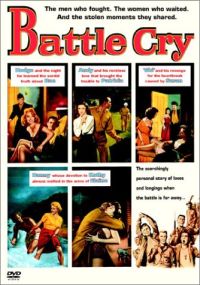
Battle Cry is a 1955 Warnercolor film, starring Van Heflin, Aldo Ray, James Whitmore, Tab Hunter, Nancy Olson, Anne Francis, Dorothy Malone, Raymond Massey, and Mona Freeman in CinemaScope. The film is based on the 1953 novel by former Marine Leon Uris, who also wrote the screenplay, and was produced and directed by Raoul Walsh. The film was shot at Camp Pendleton, California, and featured a large amount of cooperation from the United States Marine Corps.

The buddy film is a subgenre of adventure and comedy film in which two people go on an adventure, mission, or road trip. The two typically are males with contrasting personalities. The contrast is sometimes accentuated by an ethnic difference between the two. The buddy film is commonplace in Western cinema; unlike some other film genres, it endured through the 20th century with different pairings and different themes.
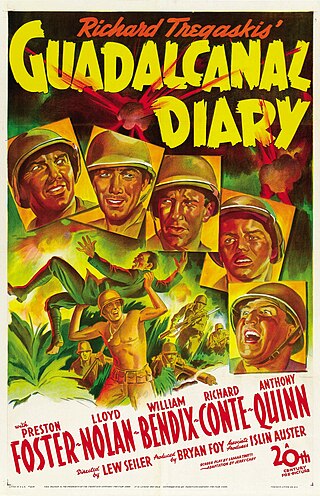
Guadalcanal Diary is a 1943 World War II war film directed by Lewis Seiler, featuring Preston Foster, Lloyd Nolan, William Bendix, Richard Conte, Anthony Quinn and the film debut of Richard Jaeckel. It is based on the book of the same name by Richard Tregaskis.
Philip Johnston was an American civil engineer who is credited with proposing the idea of using the Navajo language as a Navajo code to be used in the Pacific Theater during World War II.
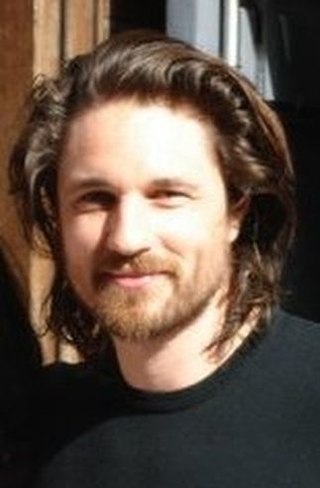
Martin Henderson is a New Zealand actor. He is known for his roles on the American medical drama series Off the Map as Dr. Ben Keeton (2011), the medical drama series Grey's Anatomy as Dr. Nathan Riggs (2015–2017), the Netflix romantic drama Virgin River as Jack Sheridan (2019–present), and for his performance as Noah Clay in the 2002 horror film The Ring, while remaining known in his home country for his teenage role as Stuart Neilson in the soap opera Shortland Street (1992–1995).
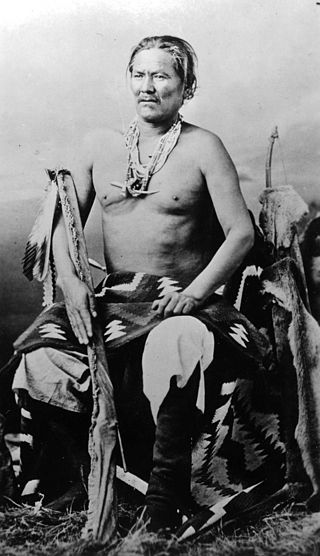
The Navajo are a Native American people of the Southwestern United States.

Santa Fe National Cemetery is a United States National Cemetery in the city of Santa Fe, in Santa Fe County, New Mexico. It encompasses 84.3 acres (34.1 ha), and as of 2021, had 68,000 interments. Administered by the United States Department of Veterans Affairs, it is one of two national cemeteries in New Mexico. It was listed on the National Register of Historic Places in 2016.

As many as 25,000 Native Americans in World War II fought actively: 21,767 in the Army, 1,910 in the Navy, 874 in the Marines, 121 in the Coast Guard, and several hundred Native American women as nurses. These figures included over one-third of all able-bodied Native American men aged 18 to 50, and even included as high as seventy percent of the population of some tribes. The first Native American to be killed in WWII was Henry E. Nolatubby from Oklahoma. He was part of the Marine Detachment serving on the USS Arizona and went down with the ship on December 7, 1941. Unlike African Americans or Asian Americans, Native Americans did not serve in segregated units and served alongside white Americans.
Merril L.Sandoval was an American Navajo World War II veteran and a member of the Navajo Code Talkers, a group of United States Marines who transmitted important messages in their native Navajo language in order to stop the Japanese from intercepting sensitive material. Sandoval took part in every Marine landing in the Pacific Ocean theater of World War II from 1943 until 1945.
Thomas Claw was an American Navajo Code Talker during World War II. He served with the 1st Marine Division throughout the Pacific theater during the war.
Willard Varnell Oliver was an American veteran of the United States Marine Corps and a member of the Navajo Code Talkers during World War II. Oliver was part of a unit of Navajos who worked to confuse Japanese forces in the Pacific during World War II through the transmission of messages in the Navajo language. His younger brother, Lloyd Oliver, was also a member of the Navajo Code Talkers. Their parents were Howard and Olive (Lee) Oliver.
Allen Dale June was an American veteran of World War II. June was one of the 29 original Navajo code talkers who served in the United States Marine Corps during the war.

Joe Morris Sr. was an American World War II United States Marine veteran and Navajo code talker.

Frank Chee Willeto was an American politician and Navajo code talker during World War II. Willeto served as the vice president of the Navajo Nation under President Milton Bluehouse, Sr. from his appointment in August 1998 until January 1999, when the Begaye administration took office.
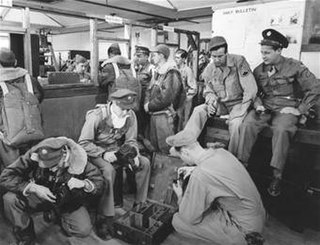
The history of New Mexico during World War II is characterized by dramatic and lasting changes to its economy, society, and politics. The state played a central role in the American war effort, contributing a disproportionately high number of servicemen and natural resources; most famously, it hosted the sites where the world's first nuclear weapon was designed, developed, and tested.

Chester Nez was an American veteran of World War II. He was the last surviving original Navajo code talker who served in the United States Marine Corps during the war.

Dr. Carl Nelson Gorman, also known as Kin-Ya-Onny-Beyeh (1907–1998) was a Navajo code talker, visual artist, painter, illustrator, and professor. He was faculty at the University of California, Davis, from 1950 until 1973. During World War II, Gorman served as a code talker with the United States Marine Corps in the Pacific.














